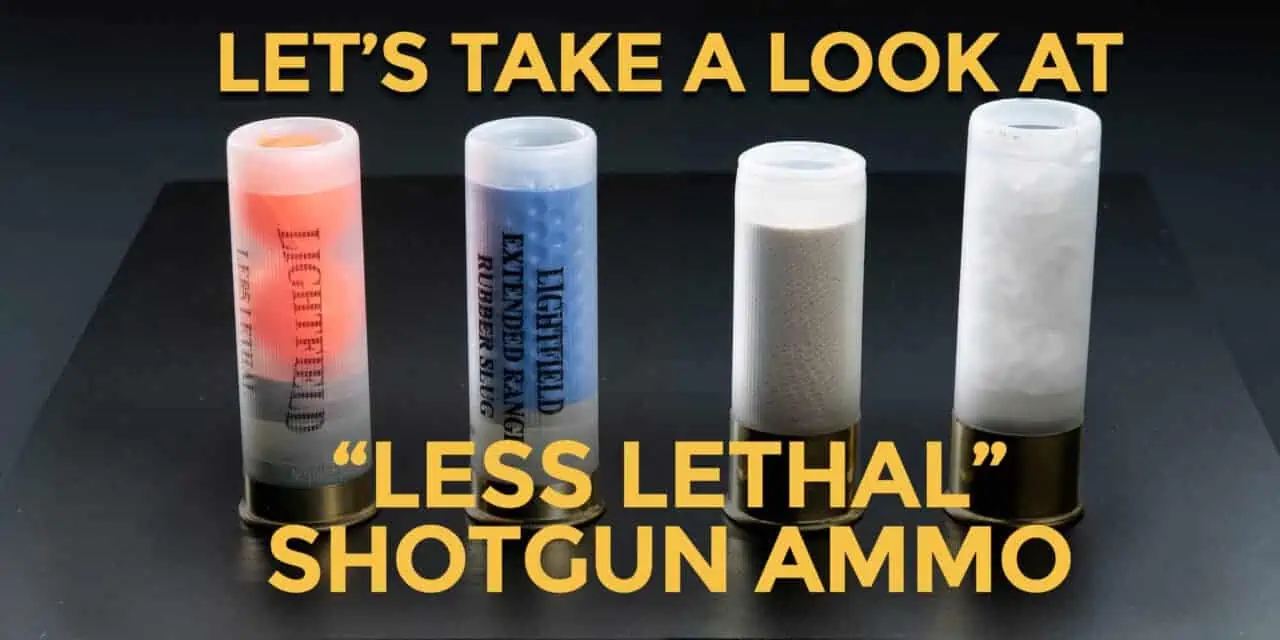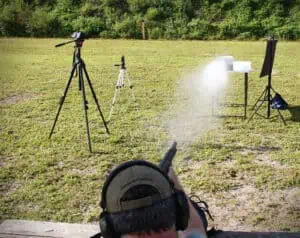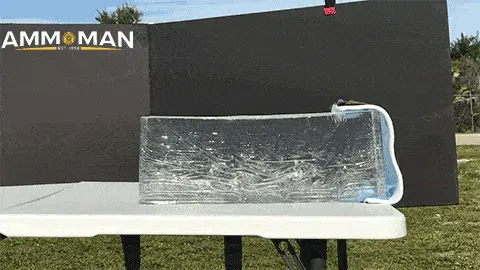Putting Less Lethal Shotgun Ammo To The Test
The shotgun is one of the oldest firearms in existence. It can trace its roots back to the first days of the black powder hand cannons which used rocks, debris, and small iron projectiles for maximum effect at close range. The shotgun evolved over the years, and soon became a trusted defensive firearm as well as an effective tool for hunting.
The flexibility of a shotgun is one of its greatest strengths. Just by switching ammo from a lightweight birdshot shell to a heavy deer slug, you can completely change the effect of your shots on the target. In addition to this, there are a number of “less lethal” options available for the shotgun. From old school classics like rock salt to more modern innovations like bean bag rounds and rubber slugs, we’re going to look at some of the less lethal shotgun ammo options that are available to the armed citizen.
Take Precautions With Less Lethal Shotgun Ammo
Which brings me to an important point. Police officers often use less lethal rounds to subdue a suspect or quell a riot. We should always remember that the mission of law enforcement is quite different than our mission as armed citizens. Law enforcement needs to worry about things like making arrests and keeping the peace.
As armed citizens, however, our task is to break contact with an attacker in order to prevent death or grievous bodily harm to ourselves or those in our care. The reasons why law enforcement use less lethal shotgun ammo such as rubber or polymer-based baton rounds or bean bag rounds may or may not be the same reasons why we might need these rounds. Proceed accordingly. As always, if you’re worried about the legal ramifications of using a less-lethal round in self-defense, go talk to a lawyer. They get paid to know this stuff.
What Does “Less Lethal” Actually Mean?
Let’s talk for a moment about what makes one round “lethal,” and another round “less lethal.”
A round that penetrates into the body of the target and connects with either the central nervous system or circulatory system tends to be a lethal round. Shutting off the supply of oxygen to the brain by shutting down the heart or causing massive blood loss is a lethal outcome of bullet penetration, as is shutting off the brain itself with a round of ammo. Less lethal shotgun rounds are designed to inflict damage on the target with lower amounts of penetration. It hurts to get hit by them, and that tends to dissuade an attacker from continuing his assault. In addition to this, a less lethal shotgun round can cause severe bruising, lacerations, fractures and in some cases, death. These are “less lethal” rounds, not “non-lethal” (more on that in a bit).
Testing Less Lethal Shotgun Ammo
We’ll be conducting our tests with four different types of less lethal shotgun ammunition:
Rock Salt. The specific round we’ll be testing is the 12 gauge version from Gum Gully Provisions
Rubber Slug. This test will use the Lightfield 12 gauge extend range round. It is labelled for use as a wildlife control round.
Bean Bag Round. We will use the “Iron Fist” 12 gauge bean bag ammunition from FireQuest.com.
Double Rubber Ball. Another 12 gauge Lightfield round, which is also labelled as wildlife control ammunition.
What This Ammo Actually Does
To get a better understanding of the effects of these rounds on a human target, we will shoot each round at a block of Clear Ballistics gel from a distance of 15 feet. This is further than the 10 foot recommended distance for testing the penetration of handgun rounds. However, it is right in-line with the recommended distances for this kind of ammunition. So, it should suit our purposes just fine. We will test the rounds twice, once through four layers of heavy clothing that is in standard use with ammunition testing, and once again with bare gel. Any penetration from any of these rounds will be measured and recorded.
As I said before, these are “less lethal” shotgun rounds, not “non-lethal.” Anything fired out of a gun has the potential to be lethal. These rounds are not the phasers of science fiction, where one shot instantly knocks someone unconscious with no ill effects afterwards. Rather, these rounds rely on inflicting severe tissue damage and massive amounts of pain in order to be effective. In doing so, there is a chance they can hit a vulnerable part of the body and cause serious injury or death.
Specialty Ammo For Special Reasons
Given that fact (and let me remind you once again I am not, nor have I ever been a lawyer, and this is not legal advice), these rounds are of very, very limited use for the armed citizen. Two of the rounds we’ll test are labelled for use as wildlife control. As far as I can tell, they are effective at the job. But just as with using wasp spray as a self-defense tool, just because something is effective against an animal doesn’t mean it will be effective against humans. These are uncommon rounds for uncommon uses, and not something that should occupy a regular position in your ammo locker.
Stay tuned, as over the next few weeks, we’ll be testing commonly available less lethal rounds to see that they can (and can’t do). Shotguns are very effective and very adaptable. We’ve used them for defensive purposes for literally centuries. Now, with modern less lethal rounds, you can have more defensive options in very limited, very specific situations, and that’s what we’ll be testing over the next few weeks.





Results of Less Lethal Shotgun rounds- Could you please tell me where on the site I’d find the outcome results for the testing that Kevin undertook with less-lethal shotgun rounds. I’d very much like to read/see about those tests. Thanks.
Everything that’s published so far is available under “Shotgun Shooting Tips” on the right side of the page.
About the science fiction phaser on stun–Doc McCoy would rush to the stunned phaser victim and evaluate, sometimes rendering medical aid. When abused, the stun function could be fatal. Falling after being stunned could be fatal, too. Sounds like the real-world TASER.
There is no non-lethal weapon. The "less-lethal" weapon could be abused. "Less-lethal" weapons MIGHT trigger some physical defect in the victim. Or the victim might be in a precarious position and wind up being fatally injured in a fall or otherwise be injured by something the victim does.
Pepper spray on a disturbed person's face could trigger that person clawing his own eyes out to get rid of that burning. How much the defender using pepper spray will be blamed for something attackers do to themselves will be determined in a courtroom and in the court of public opinion. Active shooters cornered by police kill themselves and the police catch flak for failing to apprehend.